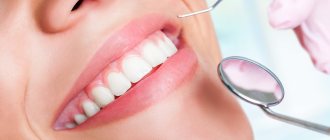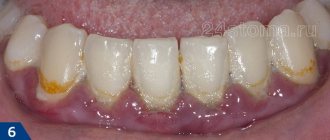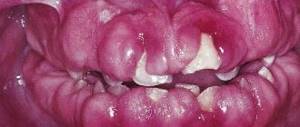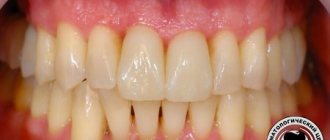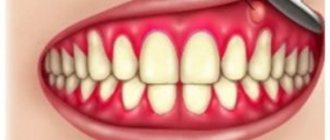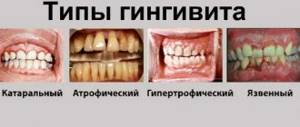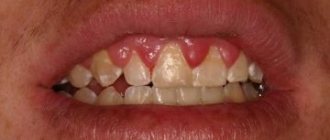Gingivitis is a dental disease in which the gums become inflamed. This is a relatively mild form - with redness of the gum tissue and its bleeding. The most common cause of this disease is dental plaque. Microbial plaque on teeth occurs as a result of poor oral hygiene. Starting treatment for gingivitis at home quickly means preventing serious consequences, including tooth loss.
Types of gingivitis
There are several classification options. But the location is divided into generalized (general, when all the gums or most of them are affected) and local (a small area of the gums near one or more teeth is inflamed) gingivitis.
There is also acute gingivitis (primary disease, which resolves with pronounced symptoms, the patient’s well-being deteriorates sharply). If a person does not go to the dentist and do not cure the disease, or does not complete the treatment, gingivitis becomes chronic. In this case, the symptoms appear less pronounced, the patient may not be bothered by anything for a long time - except for bad breath and slight bleeding during intensive brushing of the teeth. Periodically, chronic gingivitis worsens - during this period the clinical picture is similar to the acute course of the disease.
Depending on the severity there are:
- Mild degree, when inflammation covers only the gingival papillae;
- Medium – with it, almost the entire free part of the gum becomes inflamed;
- Severe, during which the disease covers both the free and alveolar parts. The risk of complications in this case is many times higher, and treatment will take longer.
Finally, there are several types of the disease itself:
- Catarrhal gingivitis is the most common and simplest acute form, in which the disease affects only soft tissues and does not reach the gums. The gums swell and bleed. Occasionally, pain is added. This form is easily treated locally.
- Simple marginal gingivitis is an inflammation of the superficial tissues of the gums, often caused by poor personal hygiene. Occurs mainly in children.
- Ulcerative gingivitis is characterized by ulceration of the gingival papillae, as a result, painful sensations appear immediately, the patient’s temperature may rise to 37.5 degrees, and health deteriorates. The pain intensifies when chewing food, especially hard food, and occurs while brushing your teeth. There is bleeding, swelling of the gums, and bad breath, which indicates the active proliferation of bacteria. If the patient does not receive qualified treatment, the disease may develop into Vincent's ulcerative-necrotizing stomatitis, in which dead areas of tissue form.
- Acute necrotizing Vincent ulcerative gingivitis is caused by a number of anaerobic bacteria (fusobacteria, treponema, spirochete, borellium), which causes necrosis (death) of the gingival papillae. It occurs with insufficient hygiene, but most often in the presence of other diseases that cause weakened immunity (frequent sore throats, flu, and also as a concomitant disease with tuberculosis and AIDS).
- Hypertrophic gingivitis is accompanied by tissue proliferation against the background of an inflammatory process. In this case, conservative treatment does not help; the patient requires surgery to remove part of the gum. There are two forms: edematous and fibrous. The edematous form of hypertrophic gingivitis is accompanied by an increase in tissue volume due to edema, the gingival papillae remain loose, and surgery is not required in most cases. Hypertrophic gingivitis in fibrous form is associated precisely with the growth and compaction of gingival tissue.
- Atrophic gingivitis , unlike hypertrophic gingivitis, is characterized by a decrease in gum volume. Most often this is due to impaired nutrition and blood supply to tissues, severe hypovitaminosis.
- Hyperplastic gingivitis is accompanied by the growth of gingival papillae, an increase in volume and blue discoloration of the gums. It usually occurs against the background of endocrine disorders and during the period of hormonal changes in the body.
- Desquamative gingivitis is characterized by intense desquamation of the gingival epithelium and severe redness of the gums.
Treatment of gingivitis at home
Gingivitis is an inflammatory process that can be eliminated without serious medical intervention. At this stage, treatment with folk remedies is effective. But if the disease is left to chance, gingivitis can cause periodontitis, a disease that is much more difficult to cure. Therefore, treatment of gingivitis in children and adults is also reliable prevention.
A decoction of oak bark, medicinal chamomile, sage, as well as commercial anti-inflammatory drugs are used to treat gingivitis at home. They have a soothing, antimicrobial and astringent effect.
Causes of gingivitis
A huge number of bacteria, including pathogenic ones, are constantly present in the oral cavity. With a decrease in immunity (general or local), pathogenic flora begins to actively multiply. This is usually due to poor hygiene and plaque deposits. Malocclusion and crooked teeth are the reasons why food particles remain in the mouth for a long time and serve as food for pathogenic bacteria. It is they who cause the development of the disease. In rare cases, gingivitis is viral or fungal in nature.
The likelihood of developing the disease increases against the background of a weakened immune system, a chronic source of infection, hormonal or endocrine disorders, improper dental treatment, poor nutrition, and lack of vitamins and microelements.
Why does gingivitis occur?
The list of causes of the disease is very wide, here are just a few of them:
- plaque;
- eating food that is too hot or too cold;
- smoking;
- diseases of the internal systems of the body (endocrine, circulatory);
- malocclusion.
The causes of gingivitis are varied, but they all lead to undesirable consequences. The disease has many forms in which it develops.
Causes of gingivitis
Gingivitis occurs for a number of reasons; they are usually divided into two groups: internal and external.
Internal ones include:
- Lack of hygiene. Bacterial plaque accumulates on the teeth, which forms a dense film. If it is not removed, within 2-3 days it crystallizes and turns into tartar. This is a constant source of infection in the oral cavity. In addition, the stone injures the gums, and an infection develops as a result of bacteria entering the wound.
- Lack of vitamins leads to decreased immunity and insufficient nutrition of gum tissue.
- Tooth growth is a natural process during which the integrity of the gums is compromised. If an infection occurs at this time, inflammation develops and gingivitis occurs.
- Malocclusion, in which a tooth or several teeth constantly injure the gums.
- Diseases of the gastrointestinal tract, which lead to a lack of vitamins and microelements, increased acidity of saliva.
External causes of gingivitis:
- An infection that came from outside. Often develops against the background of acute respiratory viral infections and other respiratory diseases, when eating poorly washed vegetables and fruits.
- Mechanical damage of any nature, including during infection of a wound resulting from inaccurate dental treatment or removal of tartar.
- When exposed to radiation or while taking certain medications.
- Smoking.
- The presence of multiple foci of caries.
Most often, gingivitis occurs in children: their immune system is still developing, so it cannot always recognize the infection in time and cope with it. Children often put dirty hands and objects into their mouths, which cause tissue damage and infection.
Features of gingivitis in children, adults and pregnant women
In general terms, gingivitis occurs in the same way for everyone, only the treatment methods differ. Adults are prescribed drug therapy, including antibiotics. The course lasts 10 days, medications are taken orally or administered intramuscularly.
Children are given antibacterial therapy and immunomodulating drugs are prescribed. In addition, the mucous membranes of the oral cavity are treated with decoctions of medicinal herbs and special gels.
Pregnant women are prescribed vitamins and safe antiseptic drugs. Antibiotics are completely excluded, but removal of tartar and plaque is mandatory.
Symptoms of gingivitis
The disease does not always manifest itself with clear symptoms, so it is important to come for preventive examinations to the dentist on time: during the examination, he will notice the manifestations of the disease and prescribe additional examination and treatment.
Bleeding gums is one of the main symptoms. However, it is also characteristic of other dental diseases, as is bad breath (halitosis), which may indicate problems with the teeth, gums or gastrointestinal tract.
Symptoms that require you to see a dentist:
- Swelling and swelling of the gums;
- Bleeding doesn't just happen when brushing your teeth;
- Sore gums;
- The presence of wounds and other formations in the oral cavity, even if they are painless;
- Change in color of the mucous membrane (gums are red or bluish);
- Retraction of the gum from the tooth, formation of a gum pocket.
If weakness occurs against this background, the temperature rises - we are talking about acute inflammation, and it is better not to postpone a visit to the doctor.
With catarrhal gingivitis, the gums remain loose. Ulcerative-necrotic - manifested by the formation of wounds and ulcers, a characteristic putrefactive odor. These signs are easy to spot during a routine oral examination. Additional patient complaints of increased tooth sensitivity, as well as the presence of plaque and tartar, also support this diagnosis.
Diagnostic methods
Typically, a dentist can diagnose gingivitis after a routine examination. But sometimes this is not enough to obtain a complete picture of the disease and exclude other dental diagnoses.
Methods for diagnosing gingivitis:
- Microbiological examination of saliva will help determine the number and composition of bacteria that caused inflammation.
- Dental X-ray - to determine the presence or absence of damage to the alveolar ligaments and exclude other diseases (periodontitis, periodontal disease).
- A general blood test will help determine the degree of inflammation and the general condition of the body.
- If there is severe tissue growth and major surgery is required, the doctor may recommend a capillary study.
Diagnosis and treatment of gingivitis is carried out by a dental therapist, but sometimes consultation with a periodontist and dental surgeon is required. If there are concomitant diseases (endocrine, hormonal, diseases of the gastrointestinal tract and ENT organs, immune disorders), it is advisable to consult with specialized specialists.
The main criteria for the treatment of gingivitis are:
- Complexity
Each specific case requires a number of therapeutic procedures. Both local and general treatment are necessary. Therapy should be aimed not only at relieving symptoms, but also at the causative factors.
- Individuality
The features of the clinical course, associated problems (their presence and nature), as well as factors of local and general defense of the patient’s body (the state of the immune system) must be taken into account.
- Systematicity
Chronic forms of the disease require regular courses of maintenance therapy to bring the disease into stable remission.
Treatment tactics depend, first of all, on the form of the disease. Let us consider in detail the specifics of treatment of three forms of gingivitis. This will help you understand the basic principles of therapy and roughly explain how your dentist will treat gingivitis.
Treatment methods
Local treatment is usually sufficient to treat uncomplicated gingivitis; in severe cases, antibiotics and surgery may be necessary. Additionally, the doctor may recommend a diet to reduce the burden on inflamed gums and also support the immune system.
Cleaning teeth from stone and plaque, treating caries lesions are the first stages of therapy. Their goal is to eliminate the root cause, the source of infection. If the plaque is not removed, the treatment will be ineffective, and after a while the disease will recur.
Next, the doctor prescribes antimicrobial and restorative treatment. Depending on the stage of the disease, they may take 10-20 days.
The goal of local treatment is to quickly relieve symptoms, relieve pain and remove inflammation. For this purpose, rinsing solutions, herbal decoctions, ointments and gels are used.
It is important not to eat or drink for at least an hour after rinsing. It is also forbidden to swallow rinses - if they enter the stomach, they can cause inflammation of the mucous membrane and even severe poisoning.
Alcohol-based solutions should be used with caution: they can burn or dry out the mucous membrane, which will lead to even greater inflammation.
Ointments and gels are rubbed into the gums and left for a while. They provide a lasting disinfectant and anti-inflammatory effect and stimulate healing processes.
The effect of treatment is enhanced if you use anti-inflammatory toothpastes. But bleaching agents with abrasives should be avoided: they can damage already inflamed gums.
Prevention
To avoid disease, it is important, first of all, to adhere to hygiene rules: brush your teeth twice a day to remove bacterial plaque, choose the right toothbrush, rinse your mouth after eating, and visit the dentist’s office for preventive purposes. You also need:
- Eat right - include more vitamin-rich foods, fiber in your diet, limit sweets and fast carbohydrates;
- Treat infectious and inflammatory diseases of the oral cavity and caries in a timely manner;
- Periodically perform professional teeth cleaning and tartar removal;
- Strengthen immunity.
At the first signs of the development of an inflammatory process, you should consult a doctor to prevent inflammation from spreading deep into the gum tissue and developing complications.
Why is it important to see a doctor?
When the first signs of gingivitis appear, you should immediately contact a qualified dentist or periodontist. This is necessary in order to confirm the diagnosis. In terms of external signs, gingivitis resembles periodontal disease or periodontitis, however, there are significant differences between these ailments.
Treatment of gingivitis is carried out according to a single scheme, regardless of the cause of the disease. Treatment usually takes place in two stages: oral hygiene (performed by a dentist) and local rinsing with antiseptic solutions.
In particular, gingivitis affects only the gums, without affecting the bone tissue. With periodontal disease, the picture is the opposite: the teeth begin to loosen, while practically no inflammation is observed in the gums. However, only an experienced doctor can determine this difference. After confirmation of the diagnosis, a treatment regimen is prescribed.
Important! The doctor must be truly experienced. In case of periodontal disease, potentially dangerous teeth are removed. With proper treatment of gingivitis, teeth are usually preserved.
